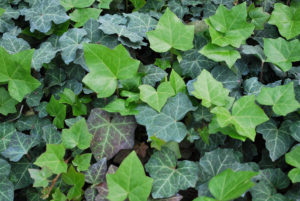
And so now they tell me what I am supposed to be doing with these blogs—I am supposed to be selling stuff. And here I have been plumbing the depths of my psyche trying to figure out how I feel every morning, searching for material to write about. It may take a while for me to get re-programmed, but here is a start at selling stuff. The thought had never occurred to me that a blog was a good medium for selling, what with me thinking that anyone with the time to read a blog is probably not working hard enough to make enough money to pay for the plants they might purchase from us. Here goes.
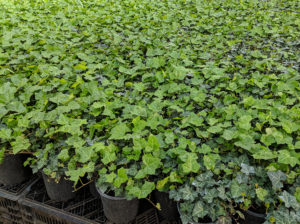
In the nursery business we waver between putting an effort into trying to unload whatever plants we have too many of and struggling to try to make whatever plants we are short of. We would get some work done around here if we did not spend so much time engaged in acrimonious debates as to who was responsible for the overages and shortages. There were a lot of denials going around, in any case.
We have 15,000 really heavy gallons of Hedera helix ‘Thorndale’ (English ivy to normal people). These are our cutting stock plants and they have been trimmed multiple times and thus have many branches and new buds and will really pop when released from the constrictions of their plastic pots. I see that another big groundcover nursery is, likewise, suffering from an excess of ivy gallons and they have attempted to solve the problem by deeply discounting their product. We are not sufficiently organized to offer discounts from time to time throughout the year as various products mysteriously appear in great abundance out in our poly houses. To offer discounts would involve someone walking around observing and making notes and then making decisions and then doing a re-programming of our very expensive computer software to reflect the new price. So, we are not going to attempt to sell overages based on price. We are going to appeal to the better nature and higher spiritual aspirations of our customer base in order to sell these things. In the meantime we will be spending the summer spacing and trimming and hoping.
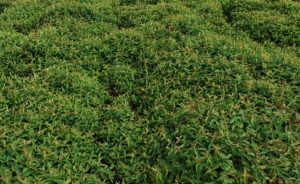
This brings up the next possible error that we can make—we could stick every cutting that we take instead of throwing them away. I tell people that decisions such as that are what got us where we are today. I get some strange looks as that slowly sinks in, that we used to stick every cutting, compounding whatever error had been made to start with. At least ten thousand of these ivy gallons were custom grown for some ethereal and mystical job that was supposed to go last summer. Because it takes a year and a half to get a good gallon developed, with roots and woody stems and lots of buds, we have to start early on these custom orders. The worst of it is not that the entire order fell through but that I cannot remember who it was so that I could mention their name a half dozen times in these blogs.
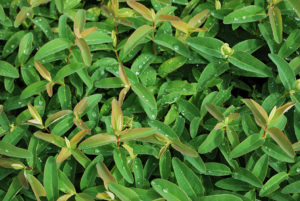
If I ever run out of either the depths of my psyche or of excess inventory to write about I plan on falling back on a very long, Shakespearean even, musing about the ethics of growing purple leaf winter creeper, Euonymus fortunei ‘Coloratus’. We have tried over the years to grow everything from Symphoricarpos chenaulti ‘Hancock’ to Deutzia ‘Nikko’ to Hypericum calycinum to willow-leaf cotoneaster as a substitute. I almost forgot Stephanandra incisa ‘Crispa’ which reminds me that I saw a very nice dwarf variety of this plant at one of Roy Klehm’s nurseries but he was always watching so I never got any cuttings. These plants had all been suggested to me as possible coloratus replacements. The customers never saw it that way, however.
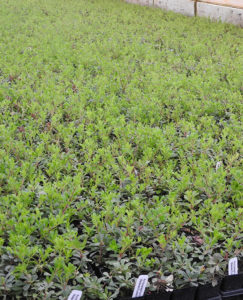
Anyhow, the latest foray into finding a coloratus substitute that might actually sell involves bearberry, kinnikinnick, Arctostaphylos uva-ursi ‘Massachusets’. This is the near ideal substitute as it is evergreen with flowers and red berries and a low running habit with some cold weather color change. In my on-going attempt to raise the level of consciousness of the landscaping public I presently have 6,500 well-established gallons to sell. They are well-established because they did not sell last year because my social media girl (personage) was not yet bugging me to write a blog.
To begin with, bearberry had a reputation for being difficult to propagate and then someone came up with this ‘Massachusetts’ strain that was significantly easier to get to root and then, after many years of adjusting the timing of when to take the cuttings and how to treat them in the winter, we now are getting a near one hundred percent take. I am really happy about that. The people who look at computers all day and who do analysis and who are responsible for turning the product in order to make money are not nearly as cheery as I am about my newly-sharpened propagation skills.
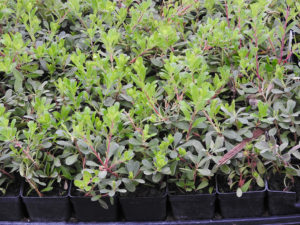
That is why we will have 6,000 2 ½” pots (200 trays of 32’s) for sale by late spring. If someone does not buy them I will pot them up into gallons and the future blogs will consist of wall-to-wall extolling and exhortations about this fine plant. Right now these plants are in a heated house and full of tender growth. Also, bearberry will universally die if the roots are disturbed during the transplanting process. I have done that experiment enough times to achieve perfect replicability. Wait until the roots are pretty thick in the pots before pulling them out for up-shifting.
Bearberry has a bad reputation for liking only acidic soil. I do not know for sure about this, however, I do know that the Morton Arboretum has discovered a luxuriant and large bearberry plant growing on limestone somewhere north of Chicago that they have been growing and giving cuttings out to nurseries. In theory this strain will successfully grow in normal soil. I am busy taking cuttings and growing on the few plants that we started with. The most difficult aspect of this part of the nursery business is that I am having to eat tofu every day in order to live long enough to reap the benefits of growing this fine plant. We will make any sacrifice here at Twixwood to provide our customers with the latest and best in plant material.
